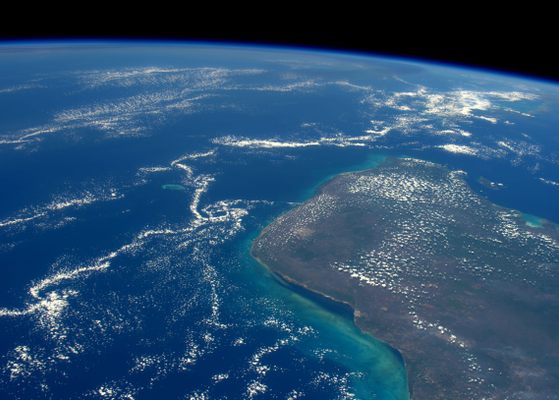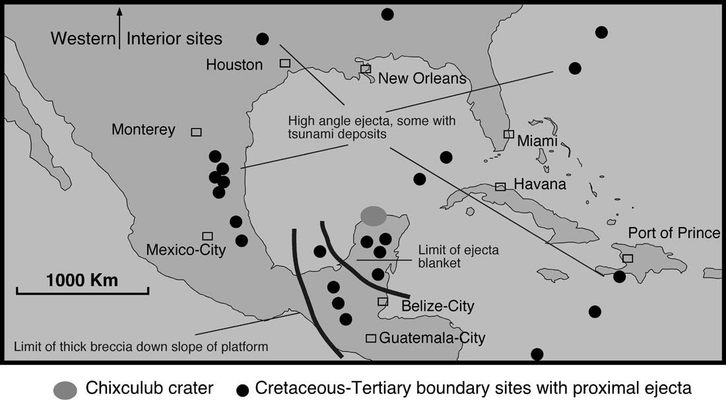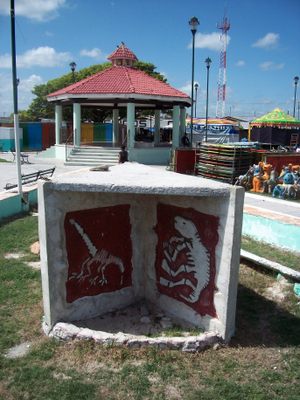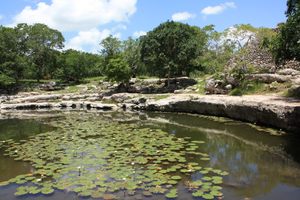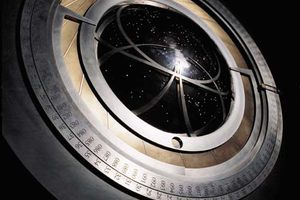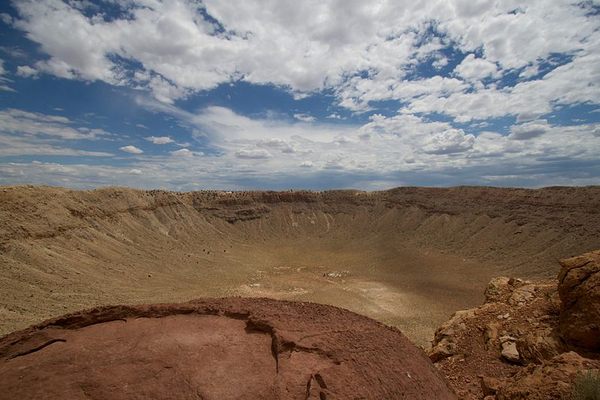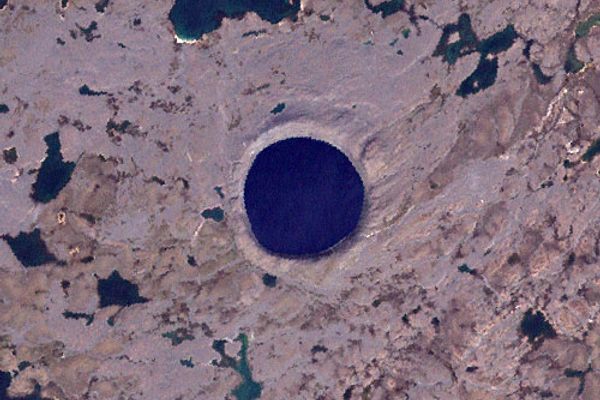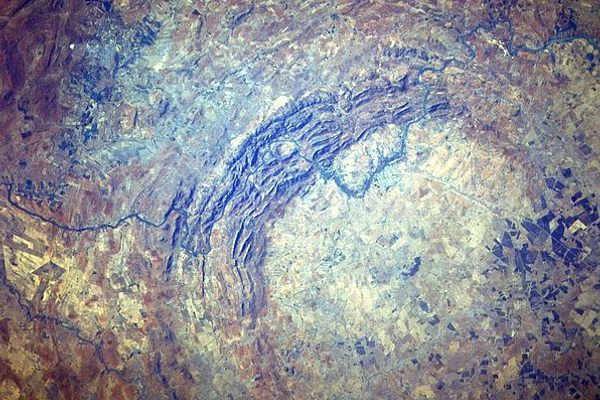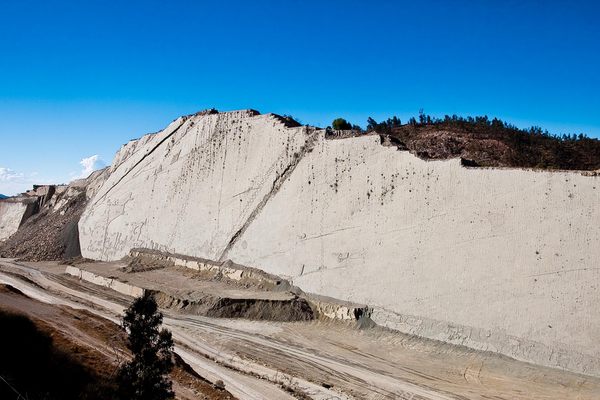About
Buried beneath thousands of feet of limestone in the Yucatán Peninsula are the remains of an impact so great that it wiped out the dinosaurs—and more than half of the species on Earth at the time. The Chicxulub Crater, named after the village that lies near its center, spans over 93 miles wide and 12 miles deep, with about half of it resting below the Gulf of Mexico.
Some 65 million years ago, an asteroid or comet the size of a small city came hurtling toward Earth. With a force of 100 million megatons of TNT (that’s 2 million times stronger than the most powerful man-made bomb), it crashed into our planet and created devastating consequences for the dinosaurs and all other life.
What Killed the Dinosaurs?When the impactor, which scientists estimate measured as much as nine miles wide, hit the ground, shockwaves rippled outwards from the site, triggering earthquakes and volcanic eruptions across the world. In the oceans, the explosion unleashed megatsunamis measuring thousands of meters high. Massive amounts of debris from the impactor and the Earth were kicked up into the atmosphere and beyond. Some of the larger ejected chunks came speeding back down, igniting in the atmosphere and setting off global firestorms. Meanwhile, the sky darkened as a cloud of dust covered the Earth, blocking sunlight and preventing photosynthesis for years.
After millions of years of erosion and sedimentation, however, evidence of the cataclysmic event is hard to come across today. Even for a spectator standing high above the crater’s center, the impact’s effects are not apparent. Perhaps the most telling feature of the surrounding landscape is the cenotes. These water-filled sinkholes, once used by the Mayans in sacrificial ceremonies, dot the crater’s edge where the rock was weakened.
How Was the Chicxulub Crater Found?In fact, it was not until 1978 that the Chicxulub Crater was finally unearthed. The discovery is generally attributed to Glen Penfield, a geophysicist who noticed the region’s unusual features while working for the Mexican oil company Pemex. While examining a magnetic survey map of the Gulf of Mexico, Penfield observed a semicircular arc suggesting the presence of an impact crater. Unbeknownst to him, a former Pemex employee had noted a similar anomaly in a gravity map of the Yucatán. However, the petroleum company prohibited this worker from publishing his findings and the map’s significance went unrealized for years before Penfield used it to confirm his suspicions.
Just a few years later, researchers like the father-and-son geology team of Luis and Walter Alvarez and the graduate student Alan Hildebrand published controversial articles that suggested a large impact from an asteroid caused the mass extinction at the end of the Cretaceous period. As evidence, scientists relied on a 65 million-year-old layer of iridium-enriched clay named the K-T boundary. They argued that only a collision with a large extraterrestrial body could account for the levels of iridium (a rare element of relative abundance in meteorites) present in the rock, and the worldwide distribution of the boundary layer.
It was also predicted and later confirmed that the extreme pressures and temperatures associated with the violent explosion would have ejected and widely distributed “shocked quartz” (a deformed type of the familiar crystalline solid) and tektites (spherules of natural glass rock).
While science inched closer to a reasonable explanation for the demise of the dinosaurs, another decade passed before Chicxulub was realized as the remains of the catastrophic event. This occurred in 1990, when a newspaper reporter informed Hildebrand of Penfield’s work and the two scientists began working together on Pemex drill samples from the site. Soon enough, the crater’s age and properties were confirmed to correlate with predictions.
Today, Chicxulub remains a hot topic of study. Some researchers use computer models to recreate the formation scenario and explain the crater’s structural changes, while others are concerned with tracing the impacting body back to its initial home in the main asteroid belt.
How Did the Dinosaurs Go Extinct?Perhaps the most controversial work, though, involves pinpointing the exact events that led to the dinosaurs’ extinction. There is considerable disagreement in the scientific community regarding whether the impact was isolated or part of a relatively short epoch of collisions in which the proceeding periods of global cooling and warming finally finished off the ill-fated beasts.
Whatever the case may be, impacts the size of Chicxulub occur on Earth about once every 100 million years, making the crater in Mexico a humbling and perhaps unsettling reminder of life’s fragility.
Related Tags
Know Before You Go
Chicxulub Puerto, the town near the center of the crater, offers very little physical evidence that it was the site of such an important event in geological history. The Museum of Science of the Chicxulub Crater offers some insight into how the crater impacted the landscape of this part of Mexico.
Many of the cenotes that can be found across the Yucatán Peninsula formed as a result of the impact, when rock was forced to the surface from deep underground.
Yucatan Family Adventure: Meteors, Pyramids & Maya Legends
Explore Maya temples and learn about the asteroid that wiped out the dinosaurs.
Book NowCommunity Contributors
Added By
Published
February 22, 2010
Updated
August 15, 2023
Sources
- http://www.space.com/scienceastronomy/planetearth/asteroid_jello_001122.html
- http://www.daviddarling.info/encyclopedia/C/Chicx.html
- http://neo.jpl.nasa.gov/images/yucatan.html
- http://en.wikipedia.org/wiki/Chicxulub_Crater
- http://en.wikipedia.org/wiki/K%E2%80%93T_boundary
- https://www.google.com/maps/place/Museo+de+Ciencias+del+Cr%C3%A1ter+de+Chicxulub/@21.1308555,-89.7808568,39282m/data=!3m1!1e3!4m14!1m8!2m7!1s+Chicxulub+Crater!3m5!1s+Chicxulub+Crater!2s21.4,+-89.516667!4m2!1d-89.516667!2d21.4!3m4!1s0x0:0x8cbb534993d3736c!8m2!3d21.1308617!4d-89.7808743
